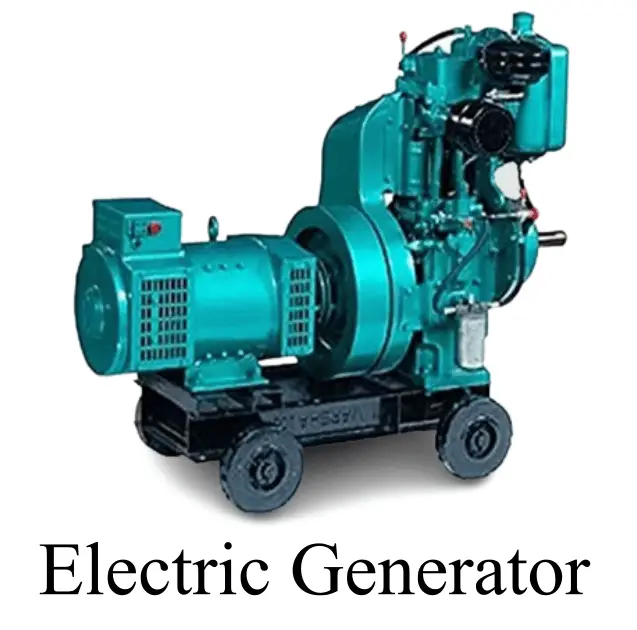This article describes the difference between a motor and a generator. Electrical machines are utilized for numerous residential and industrial purposes. These machines function by converting different forms of energy into another form depending on the type of energy required to be generated for a particular application.
Based on the type of energy conversion performed by the electrical machines, they can be broadly classified into the following two categories:
- Electric Motor
- Electric Generator
This article will focus on the major differences between an electric motor and an electric generator, along with a basic introduction to what a motor and generator are.
What is an Electric Motor?
An electric motor is an electrical machine that is used to transform electric energy into mechanical energy. Electric motors are powered by means of DC or AC sources of current. DC sources include batteries, rectifiers, etc. While AC sources include generators, inverters, power grids, etc. Additionally, electric motors require an initial torque to start working which is generated by means of the electric current cutting the magnetic field.

The electric motor is mainly made up of three main parts viz. the rotor, stator, and commutator. The rotor is the rotatory part of the electric motor that is responsible for driving heavy mechanical loads. While the stator is the stationary part of the electric motor that induces the rotational magnetic flux on the rotor. While the commutator is responsible for switching the direction of the current flow.
The electric motor operates on the principle of a coil of wire wound around the rotor of the electric motor that carries electric current and is placed in between the permanent magnet’s magnetic field.
Electric motors find their applications in a wide variety of home appliances such as air-conditioners, heaters, electric fans, electric vehicles, etc. Electric motors are also used for several commercial purposes such as industrial fans, power tools, blowers, turbines, pumps, etc.
What is an Electric Generator?
An electric generator is an electrical machine that is used to transform mechanical energy into electrical energy. Electric generators generate an electric current in comparison to electric motors that are supplied with electric current to the rotor.

A gas turbine, diesel engine, wind turbine, etc. are responsible for supplying mechanical input to the rotor of the electric generator. The electric generator operates on the electromagnetic induction principle.
Similar to an electric motor, an electric generator is also made up of two main components namely – the stator and rotor. The rotor of the electric generator generates rotational magnetic flux, that in turn induces an electromotive force (EMF) on the armature winding of the static stator of the electric generator.
Electric generators are widely used in power stations and industries where they have driven water turbines, hydro turbines, power plants, etc.
Difference Between Motor and Generator
Both being electromechanical devices having a wide range of applications, electric motors, and generators have some notable differences as listed in the table below.
| Parameter | Electric Motor | Electric Generator |
| Definition | An electric motor is a machine that converts electrical energy into mechanical energy. | An electric generator is a machine that converts mechanical energy into electrical energy. |
| Types of Motor | Depending on the kind of power supplied to the electric motor it is divided into the following two categories: AC motor & DC motor | Depending on the kind of power supplied by the electric generator it is divided into the following two categories: AC generator / Alternator DC generator / Dynamo |
| Working Principle | An electric motor works on the principle of a conducting coil carrying electric current when kept in an existing magnetic field. | Electric generator operates on the principle of electromagnetic induction. |
| Applied Law | Fleming’s left-hand law is followed by an electric motor. | Fleming’s right-hand law is followed by an electric generator. |
| Electricity usage/ generation | An electric motor utilizes electric current to rotate. | The electric generator produces an electric current. |
| Shaft rotation | The reason for shaft rotation in an electric motor is the interaction of magnetic flux and the armature current. | The reason for shaft rotation in an electric generator is the external mechanical forces provided by the turbines to the rotor, which is in turn connected to the shaft. |
| Current flow | External AC/DC current is provided to the motor armature winding. | While electric current is drawn from the armature windings of the generator. |
| Electromotive force | Electromotive force is also referred to as ‘Back EMF’ as it generates a torque that aids in the rotation of the motor. | Voltage drop is produced at the ends of the external mechanical load when the EMF is induced on the armature windings of the generator. |
| Applications | Electric motors find a wide range of applications in a variety of electrical devices and machinery such as air conditioners, electric fans, electric cars, pumps, etc. | Electric generators find a wide range of industrial applications such as power stations, battery charging, laboratory testing, etc. |
Conclusion
In conclusion, this article discusses the prominent differences between electric motors and electric generators. The most significant difference between them lies in their principle of operation i.e., the electric motors take electric energy as input and transform it into mechanical energy, while electric generators transform mechanical energy taken from turbines and engines to generate electric current to drive electrical loads.